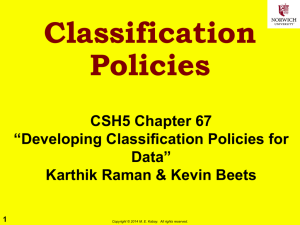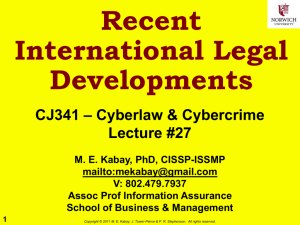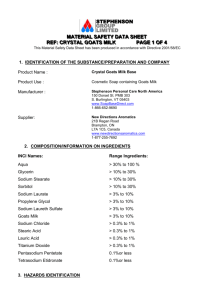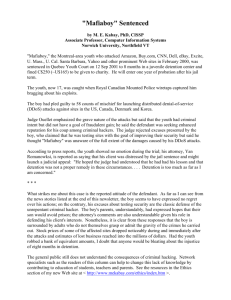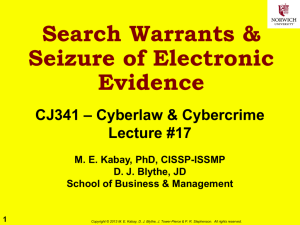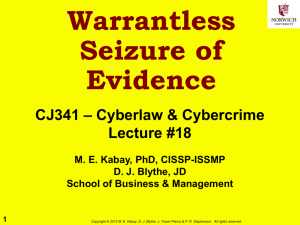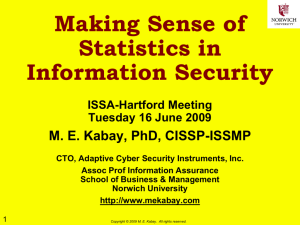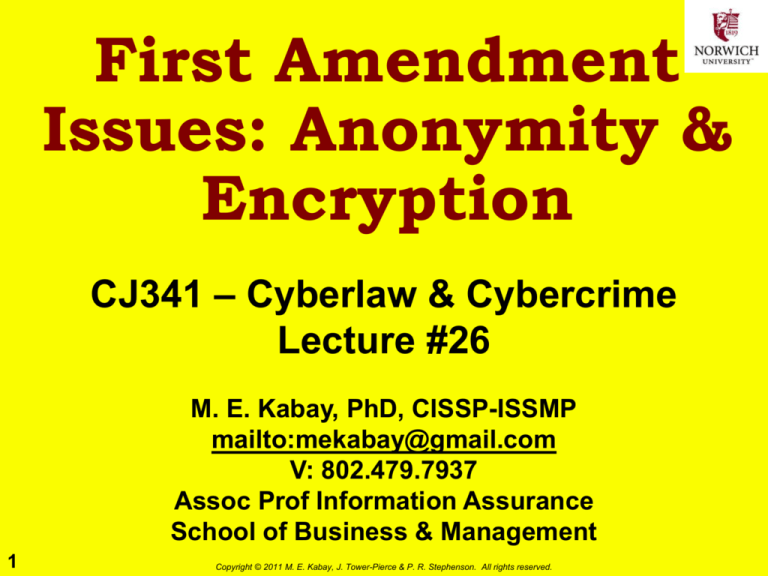
First Amendment
Issues: Anonymity &
Encryption
CJ341 – Cyberlaw & Cybercrime
Lecture #26
M. E. Kabay, PhD, CISSP-ISSMP
mailto:mekabay@gmail.com
V: 802.479.7937
Assoc Prof Information Assurance
School of Business & Management
1
Copyright © 2011 M. E. Kabay, J. Tower-Pierce & P. R. Stephenson. All rights reserved.
Topics
Contrary to syllabus,
there is no discussion of
entrapment in this lecture
Anonymity and Privacy
Privacy and Guilt
A Modest Proposal
The Madness of King George
Fourth Amendment
Anonymity
First Amendment Defenses & Computers
Cryptography Exports
Key Escrow
ICE Seizures
With some slides kindly provided
by Prof Robert Guess, MSIA
Wassenaar Arrangement
from Tidewater Community College
2
Copyright © 2011 M. E. Kabay, J. Tower-Pierce & P. R. Stephenson. All rights reserved.
Anonymity and
Privacy
Sun CEO Scott McNeely caused a furor when he stated
“You have zero privacy anyway. Get over it .”
25 Million Surveillance Cameras are in use worldwide.
Houston Chief of Police Harold Hurtt
Called for placing surveillance cameras in public
areas and private homes
He said “I know a lot of people are concerned
about Big Brother, but my response to that is, if
you are not doing anything wrong, why should you
worry about it?”
CLASS DISCUSSION:
How would you answer that?
3
Copyright © 2011 M. E. Kabay, J. Tower-Pierce & P. R. Stephenson. All rights reserved.
Used by gracious permission
of Prof Robert Guess, MSIA
Tidewater Community College
On Privacy and Guilt
The issue is not whether someone desiring privacy has done
anything wrong:
The issue is whether those
invading privacy are doing
something wrong.
FBI Director J. Edgar Hoover
detested civil rights workers
and ordered 24-hour
surveillance at taxpayer
expense based entirely on
his dislike of their politics *
President Richard M. Nixon
ordered illegal surveillance
of his political “enemies” by
the FBI and the Secret Service at taxpayer expense
* http://www.icdc.com/~paulwolf/cointelpro/churchfinalreportIIIb.htm
** http://watergate.info/impeachment/impeachment-articles.shtml
4
Copyright © 2011 M. E. Kabay, J. Tower-Pierce & P. R. Stephenson. All rights reserved.
A Modest
Proposal
5
One possible answer to
the privacy dilemma:
Eliminate privacy
(governmental,
corporate, and
individual) and
Create a completely
open society
Criminal hackers chant “Information Wants to be
Free” (well, for everyone else’s information)
Everyone should know everything about everyone
CLASS DISCUSSION:
Is that a wise course of action?
Used by gracious permission
Imagine the consequences
of Prof Robert Guess, MSIA
Copyright © 2011 M. E. Kabay, J. Tower-Pierce & P. R. Stephenson. All rights reserved.
Tidewater Community College
The Madness of King George
American Colonists engaged in
barter and trade to avoid
paying taxes to the Crown
In response, King George III
issued “Writs of Assistance” to
Colonial Governors
This power was widely abused
for wholesale arrests,
searches, and seizures
The founders of the United
States of America deliberately
decided to include
constitutional protection from
such governmental abuse
6
Copyright © 2011 M. E. Kabay, J. Tower-Pierce & P. R. Stephenson. All rights reserved.
Used by gracious permission
of Prof Robert Guess, MSIA
Tidewater Community College
The Fourth Amendment to
the US Constitution (again)
7
The right of the people to be secure in their
persons, houses, papers, and effects, against
unreasonable searches and seizures, shall not be
violated, and no Warrants shall issue, but
upon probable cause, supported by Oath or
affirmation, and particularly describing the
place to be searched, and the persons or things
to be seized.
Copyright © 2011 M. E. Kabay, J. Tower-Pierce & P. R. Stephenson. All rights reserved.
Anonymity
Major challenges to criminal law
Ability to exist anonymously in cyberspace
Identity & pseudonymity
Are these people really who they claim
to be?
Technology
E.g., anonymous remailers
Ability of LE/legislators/gov’t/attorneys
to keep pace with technology
8
Copyright © 2011 M. E. Kabay, J. Tower-Pierce & P. R. Stephenson. All rights reserved.
Ban Anonymity?
Would a ban on Internet anonymity
reduce crime?
See http://www.p2pnet.net/story/10336
Brazilian politician called for ban
on anonymity in 2006
His proposed bill, if made into law,
would have made it a crime for
anyone to anonymously send an
email, join a chat, write a blog,
download content, disseminate
virus or Trojans, and access banks
or networks without proper
authorization
Do you think this is a good idea for
citizens of
China?
Why or why not?
the USA?
9
Copyright © 2011 M. E. Kabay, J. Tower-Pierce & P. R. Stephenson. All rights reserved.
Circumventing Anonymity
Users are not always as “anonymous”
as they think
Social network users sometimes
believe they are in a private space
Reveal confidential information
Show pictures of crimes (e.g.,
underage drinking of alcohol,
consumption illegal drugs)
Attack others in cyberbullying
But most social networks allow open
access
School administrators
Potential employers
Technology
Tracking programs
Interesting article (April 2008):
Forensic tools
10
http://tinyurl.com/5g6xox
Copyright © 2011 M. E. Kabay, J. Tower-Pierce & P. R. Stephenson. All rights reserved.
First Amendment Defenses &
Computers
First Amendment of US Constitution (again)
Congress shall make no law respecting an
establishment of religion, or prohibiting the free
exercise thereof; or abridging the freedom of speech,
or of the press; or the right of the people peaceably to
assemble, and to petition the Government for a
redress of grievances.
Citing 1st Amendment principles, attorneys have
tried to argue that certain computer-related
activities are protected
Computer programs in general
Viruses
Encryption
11
Copyright © 2011 M. E. Kabay, J. Tower-Pierce & P. R. Stephenson. All rights reserved.
Computer Programs &
Cryptography
Not easily lumped into protected speech category
Gov’t usually can’t prevent creation of code or
dissemination
Limitations can exist and be enforced if
necessary to protect human welfare, but not easy to do
so
In criminal cases, no bright-line rule about characterizing
computer programs & conduct as protected
E.g., US v. Mendelsohn, no valid first amendment claim
where computer program was only directed to
committing a crime, and not directed to any ideas or
consequences
In other cases, defendant’s conduct could be deemed
protected expression
But 1st amendment does not protect deeds, especially if
they damage property or infringe rights
12
Copyright © 2011 M. E. Kabay, J. Tower-Pierce & P. R. Stephenson. All rights reserved.
Cryptography and the Law of
Unintended Consequences
People are afraid of
Identity theft
Computer intrusions
Illegal / illicit surveillance
Other fraud and abuse
A side-effect is the increasing use of
cryptographic protocols
Cryptography is a two-edged sword
A benefit when you employ it
A harm when your opponent employs it
13
Copyright © 2011 M. E. Kabay, J. Tower-Pierce & P. R. Stephenson. All rights reserved.
Used by gracious permission
of Prof Robert Guess, MSIA
Tidewater Community College
Cryptoanarchy
Cryptoanarchy: “the proliferation of
cryptography that provides the benefits
of confidentiality protection but does
nothing about its harms” (Denning)
This view led to the Clipper Chip fiasco (see below)
Failure to provide crypto keys in Britain ~2-5 yr
sentence
France requires registration of crypto keys
But crypto not a major problem for LE because
Strong crypto algorithm built on a weak platform (OS)
or poorly written may be weak and subject to
penetration
Progress in cryptanalysis makes crypto less of a
problem for LE
Massively parallel applications like AccessData DNA
help cryptanalysis (see EFF projects on DES)
Many argue that to criminalize crypto would be an
Used by gracious permission
INFOSEC disaster
14
Copyright © 2011 M. E. Kabay, J. Tower-Pierce & P. R. Stephenson. All rights reserved.
of Prof Robert Guess, MSIA
Tidewater Community College
US Legal Status of
Encryption
The ITAR
The Zimmerman Case
The Clipper Chip & Key
Escrow
The Bernstein Case
The EAR
ICE Seizures
Wassenaar Arrangement
15
Copyright © 2011 M. E. Kabay, J. Tower-Pierce & P. R. Stephenson. All rights reserved.
The ITAR
International Traffic in Arms
Regulations
Administered by Department of
State
Until 1996, severely restricted
export of cryptographic hardware
and software as munitions
Constant protests from
cryptographers and companies
Nonsensical restriction
Interference with trade
Putting US suppliers at
disadvantage
16
Copyright © 2011 M. E. Kabay, J. Tower-Pierce & P. R. Stephenson. All rights reserved.
(ITAR)
17
Copyright © 2011 M. E. Kabay, J. Tower-Pierce & P. R. Stephenson. All rights reserved.
The Zimmermann Case
Phil Zimmermann created
PGP* in early 1990s
Code was freely available
Someone posted code to
BBS overseas
US government accused
Zimmermann of violating
the ITAR
World-wide protests
Phil Zimmermann Defense
Fund
Eventually dropped the
prosecution
18
*PGP = Pretty Good Privacy (named after
Ralph’s Pretty
Grocery
Store
from Lake
Woebegone)
Copyright © Good
2011 M. E. Kabay,
J. Tower-Pierce
& P. R. Stephenson.
All rights reserved.
The EAR
Export Administration Regulations
Administered by Department of Commerce
Encryption shifted from ITAR to EAR in 1996
Welcome change – liberalized regulations
Updated 2008-10-03: see
http://www.bis.doc.gov/encryption/default.htm
See next slide
http://www.access.gpo.gov/bis/ear/ear_data.html
19
Copyright © 2011 M. E. Kabay, J. Tower-Pierce & P. R. Stephenson. All rights reserved.
EAR Updated 2008
20
Copyright © 2011 M. E. Kabay, J. Tower-Pierce & P. R. Stephenson. All rights reserved.
(Much more
below)
Cryptographic Regulations
NSA / Department of Commerce study
found that regulation had “a negative
effect on US competitiveness”
No domestic limitation on use or sale
Bureau of Export Administration (BXA)
License required for export of strong
crypto
No export to Cuba, Iran, Iraq*, Libya, North Korea,
Sudan, and Syria
Code as Speech - Bernstein V US State Dept (next
slide)
21
Copyright © 2011 M. E. Kabay, J. Tower-Pierce & P. R. Stephenson. All rights reserved.
Used by gracious permission
of Prof Robert Guess, MSIA
Tidewater Community College
Bernstein v. US State Dept
UC Berkeley student Daniel Bernstein
22
wanted to post Snuffle encryption
technology online
Gov’t feared spread of technology
Act enacted restricting export
Bernstein challenged Act, claiming
source code for computer
cryptography program was protected
under 1st Amendment
Court found code = language, which =
speech
Gov’t could not restrict
dissemination (disovulation??)
Case rendered moot when gov’t
switched to EAR instead of ITAR –
Used by gracious permission
Bernstein lost standing in court
of Prof Robert Guess, MSIA
Copyright © 2011 M. E. Kabay, J. Tower-Pierce & P. R. Stephenson. All rights reserved.
Tidewater Community College
Key Escrow
When users encrypt critical data, must have way of
decrypting
User leaves
User becomes non-cooperative
(or dies)
Can store versions of key or
alternate keys
Public Key Cryptosystem (PKC)
allows encryption to multiple
public keys
Any owner of corresponding
private key can decrypt the
ciphertext
Modern cryptographic products (e.g., PGP) offer
escrow functions for corporate users
23
Copyright © 2011 M. E. Kabay, J. Tower-Pierce & P. R. Stephenson. All rights reserved.
(Clipper Chip)
24
Copyright © 2011 M. E. Kabay, J. Tower-Pierce & P. R. Stephenson. All rights reserved.
Clipper Chip & Key Escrow
(1993)
Encryption had been domain of military (esp NSA)
for decades
By early 1990s, personal computers made enough
computational power available for general use by
the public
Pretty Good Privacy implemented PKC
April 1993: Clinton administration proposed
Clipper Chip
Phones, fax, modems to
be equipped with special
chip (Clipper) to
implement SKIPJACK
algorithm
Government would access
LEAF (Law Enforcement
Access Field) to decrypt
25
Copyright © 2011 M. E. Kabay, J. Tower-Pierce & P. R. Stephenson. All rights reserved.
Clipper Chip (cont’d)
Reaction overwhelmingly negative
Secret algorithms contemptible
Details of the Clipper Chip were found thrown out in
trash of manufacturer
Committee of experts eventually given access to the
code; pronounced OK
Proposal would be meaningful only if other encryption
were made illegal
“Mandatory key escrow”
Key escrow proposal said to be open to abuse
But required collusion of people in 2 separate
agencies of US government
Proposal finally abandoned in 2000
26
Copyright © 2011 M. E. Kabay, J. Tower-Pierce & P. R. Stephenson. All rights reserved.
SAFE Act of 1997 (failed)
SAFE Act (Security and Freedom through
Encryption) of 1997
Attempted amendment to 18 USC by adding new
Chapter 123 with
§2801. Definitions
§2802. Freedom to use encryption
§2803. Freedom to sell encryption
§2804. Prohibition on mandatory key escrow
§2805. Unlawful use of encryption in
furtherance of a criminal act
Failed to pass into law
Currently, there are no restrictions whatever on
the use of encryption inside the USA
27
Copyright © 2011 M. E. Kabay, J. Tower-Pierce & P. R. Stephenson. All rights reserved.
US ICE Seizures: Boucher
Dec 2006: Sebastian Boucher
Canadian citizen
Legal resident of USA
Crossed US border at Derby
Line, VT
US ICE (Immigration & Customs
Enforcement)
Inspected computer with
permission
Found adult pornography
Then found some child pornography on Z: drive
Z: drive encrypted using PGP disk encryption
(cont’d on following slide)
28
Copyright © 2011 M. E. Kabay, J. Tower-Pierce & P. R. Stephenson. All rights reserved.
US ICE and Encryption [2]
29
2007: Grand Jury issues subpoena
Required Boucher to divulge decryption key for Z:
drive
Judge Jerome J. Niedermeier then
overturned subpoena on 5th
Amendment grounds against selfincrimination
Issues:
Forcing revelation of information held
in mind of accused is protected by 5th
Amendment.
But there is case law where self-incrimination
protection forfeited by permission for search
See article by John Curran of Associated Press about
What about
case: http://tinyurl.com/668v2u
Articles by Prof Kabay about implications of case:
National security?
http://tinyurl.com/5cs8yt http://tinyurl.com/68keob
http://tinyurl.com/6g2ly5
Corporate info?
Blog by Debbie Schlussel: http://tinyurl.com/2hfopx
Copyright © 2011 M. E. Kabay, J. Tower-Pierce & P. R. Stephenson. All rights reserved.
Wassenaar Arrangement
Wassenaar Arrangement on
Export Controls for Conventional
Arms and Dual-Use Goods and
Technologies
http://www.wassenaar.org/
Named after town in
Netherlands
Established in 1995 by 28
countries
Follow-up to the Coordinating
Committee for Multilateral
Export Controls (COCOM)
Intended to prevent export
of encryption to “dangerous”
countries (Soviet bloc)
Completed 1998
Provides framework to be implemented by signatory
countries
30
Copyright © 2011 M. E. Kabay, J. Tower-Pierce & P. R. Stephenson. All rights reserved.
Wassenaar (cont’d)
Liberalized restrictions
on encryption
No restrictions on
export of encryption
products for personal
use
No restrictions on
Internet publishing of
encryption algorithms
Public domain
encryption
software freely
exportable
31
Copyright © 2011 M. E. Kabay, J. Tower-Pierce & P. R. Stephenson. All rights reserved.
(Wassenaar)
32
Copyright © 2011 M. E. Kabay, J. Tower-Pierce & P. R. Stephenson. All rights reserved.
DISCUSSION
33
Copyright © 2011 M. E. Kabay, J. Tower-Pierce & P. R. Stephenson. All rights reserved.

